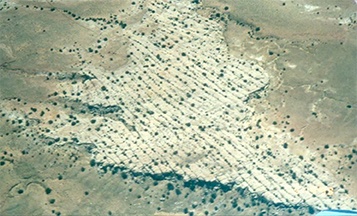
A significant amount of U.S. domestic oil production comes from shale. Extracting oil and gas from these unconventional reservoirs normally requires drilling horizontal wells and using hydraulic fracturing techniques. Yet predicting the full effect of these techniques is still uncertain because the understanding of how fluid flows through shale is still evolving.
Dr. David Schechter’s research group has developed a new type of simulator that better illustrates and predicts the effects of these techniques. This robust simulator draws on data from laboratory experiments and combines it with known geologic data on fractures. Then it uses unstructured gridding and newly developed coding to create models that improve the understanding of:
- how fractures affect reservoir flow
- how fracturing fluids with added surfactants (soaps) affect oil recovery
- which enhanced oil recovery processes are best for different reservoir situations

In addition to improving understanding, the research group used this data and these models to challenge current theories on fluid retention in reservoirs.
Schechter, an associate professor and the Aghorn Energy Career Development Professor in the Harold Vance Department of Petroleum Engineering at Texas A&M University, is no stranger to fractures. His research interests cover geological and petrophysical analysis, and he is quick to explain fracture fundamentals.
“Fractures are not necessarily chaotic in reservoir rocks,” said Schechter. “If you know the rules of rock mechanics, and you study outcrops on the surface and the subsurface with downhole tools, then you can generate fracture networks based on certain known rules. Some fractures are well-behaved regarding fracture spacing and length, some aren’t and some are irregularly spaced. If we have enough core data, if we understand rock mechanics and the stresses the basin has undergone, then the resulting fracture patterns usually adhere to simple rules.”
https://today.tamu.edu/2016/05/11/texas-am-energy-institute-to-share-in-20m-department-of-energy-grant-for-fossil-energy-research/
Water flows in surface fractures on rock outcrops. This attracts vegetation, as shown in the aerial photo (courtesy of John Lorenz). In the subsurface, similar fracture patterns allow the transport and production of oil. Geologists map surface outcrops of rock with scan lines, creating maps of fracture patterns in liquid-bearing formations. Schechter’s group converts these maps into reservoir simulation grids using a technique called unstructured gridding. In this technique, fractures are represented with complex polygonal grids, not the simple straight-lined Cartesian grids most software uses.
One student, Jianlei Sun, wrote a code that converts fracture patterns and unstructured grids into sophisticated simulation grid systems. The code contains properties of interest needed by the simulator, such as fracture strike and direction, crack size, and the length and height of the fracture.
###
Continue reading this story by Nancy Luedke on the College of Engineering website.





